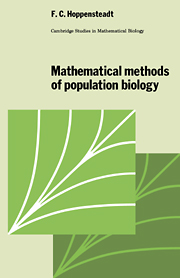
-
Select format
-
- Publisher:
- Cambridge University Press
- Publication date:
- May 2010
- February 1982
- ISBN:
- 9780511624087
- 9780521282567
- Dimensions:
- Weight & Pages:
- Dimensions:
- (216 x 138 mm)
- Weight & Pages:
- 0.21kg, 160 Pages
You may already have access via personal or institutional login
Book description
This introduction to mathematical methods that are useful for studying population phenomena is intended for advanced undergraduate and graduate students, and will be accessible to scientists who do not have a strong mathematics background. The material is graded in mathematical difficulty. The earlier parts of the book involve elementary diference equations while later chapters present topics that require more mathematical preparation. Models of total population and population age structure are first derived and studied, and then models of random population events are presented in terms of Markov chains. The last two chapters deal with mathematical methods used to uncover qualitative behaviour of more complicated difference equations. Each chapter begins with a simple model, usually of some historical interest, that defines the primary goals of the chapter. Exercises, for which solutions are provided, illustrate material in the text and also deal with models more advanced than those derived and studied in the text.
Reviews
"What makes for a good mathematics textbook? Challenging, didactic exercises with hints and solutions are a sine qua non: without them you might have a good monograph, but not a good text. Score several points for Hoppensteadt's book, with its meaty exercises...I would recommend the book for a senior or graduate-level course...also valuable as a sourcebook of ideas for applied mathematicians who want to get into this branch of mathematical biology." Mathematical Biosciences
Contents
Metrics
Full text views
Full text views help Loading metrics...
Loading metrics...
* Views captured on Cambridge Core between #date#. This data will be updated every 24 hours.
Usage data cannot currently be displayed.
Accessibility standard: Unknown
Why this information is here
This section outlines the accessibility features of this content - including support for screen readers, full keyboard navigation and high-contrast display options. This may not be relevant for you.
Accessibility Information
Accessibility compliance for the PDF of this book is currently unknown and may be updated in the future.


